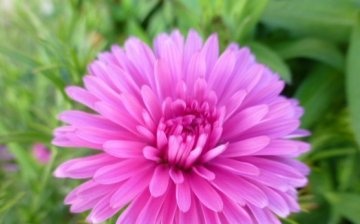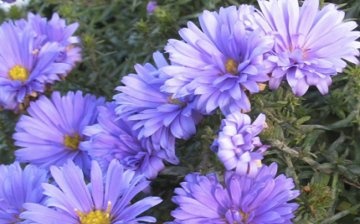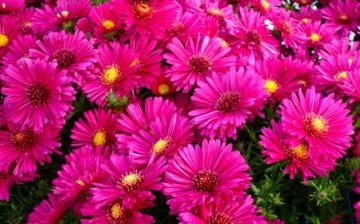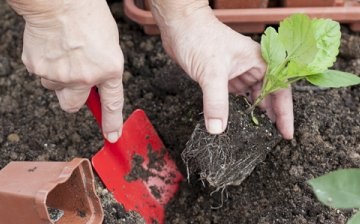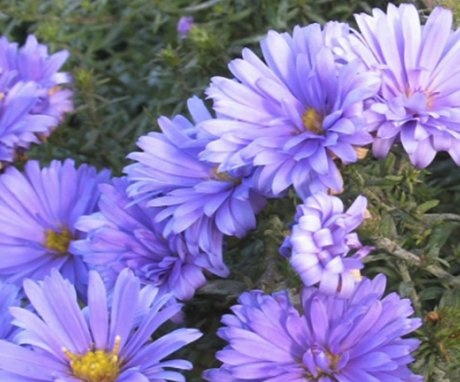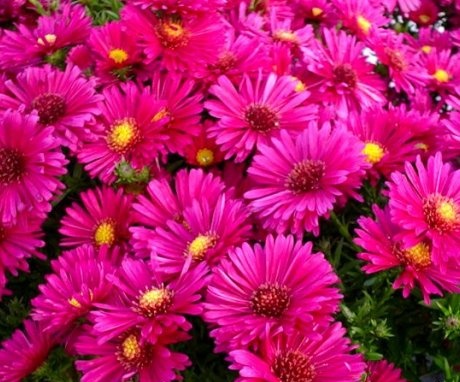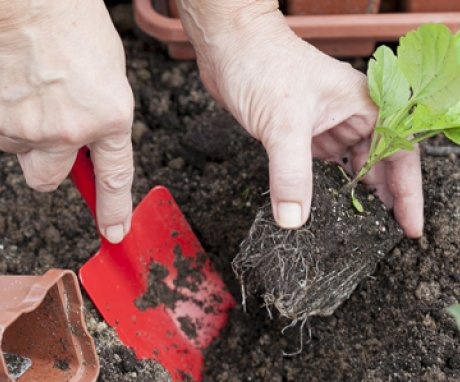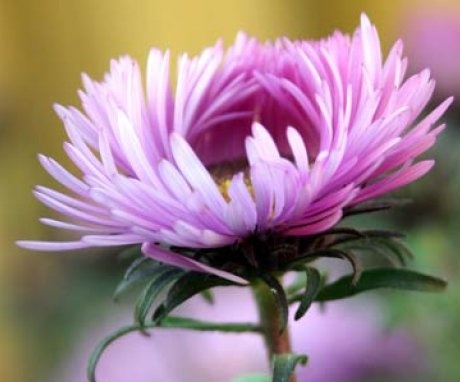Shrub aster: varieties, reproduction and plant care
Shrub aster is a perennial plant. Its height reaches 90 cm, and due to the fact that the stems are highly branching, the bush resembles a ball in shape. Leaves are oval, oblong, serrated at the edges, densely located on pubescent branches. From the upper part they have a roughness, from the lower side they are naked. Hard, dark green.
Buds are formed at the tops of numerous branches. Flowers are medium in size, up to 7 cm in diameter, single. The color is white, purple or blue. The core, a basket of yellow flowers, has a size of 2 cm. It grows well on dry and sandy soils. The flowering period begins in late August or September and lasts 6-7 weeks. The plant tolerates frost well, it is unpretentious in care.
Content:
Shrub aster varieties
Most popular varieties of asters shrub:
- Aster shrub Jenny. This is a low grade of asters. The bush reaches a height of 40 cm. The stems branch. The flowers are medium in size, the tongues are colored red. The blooming period begins in June. Long flowering.
- Shrub aster Wood’spurple. The aster bush of this variety can reach a height of 50 cm. Flowering is abundant, the core of the flower consists of a basket of small yellow inflorescences, surrounded by 25-30 tongues of a pinkish-purple hue. It has a double flowering period: late spring - early summer and late summer - early autumn. Grows well in a well-lit place. It is recommended to replant once every 4 years.
- Shrub aster Kristina. It is a perennial plant. This variety is valuable because the flowering period begins in the fall and lasts until the first frost, abundant flowering begins in October, when the plant is almost completely covered with small flowers. Kristina bushes grow only 30 cm in height. Therefore, it is often used as a curb plant or as a hedge. Due to the density of the branches, the bushes are round and dense. Flowers are painted in white, sometimes pinkish-white tone, semi-double tongues, suitable for any garden or flower bed. Leaves are small, oblong, emerald colored.
- Shrub aster Starlight. Perennial bush. Its stems are erect, pubescent. They branch strongly, the bush forms a ball or oval shape. The size of the bush reaches 50 cm. It tolerates frost and drought well. Blooms profusely in a light purple tone. The flowering period begins in August or September and can last until cold weather.
Caring for shrubby aster
For planting shrubby asters, choose a bright, well-warmed place. The soil should be loose and well-drained. These conditions must be met in order to get a healthy, lush and abundant flowering bush. In the shade or partial shade, the plant will develop poorly, and if the soil becomes waterlogged, flowering becomes scarce, and in the future the plant may die. So that the bush keeps in shape ball and did not fall apart, the aster is planted in places sheltered from strong winds and drafts.
Watering asters:
- It is necessary to water the shrub aster regularly, especially during the growing period and dry months.
- Avoid overflow, but there should be enough moisture for the bush.
- After watering, it is recommended to loosen the soil around the bush shallowly and remove weeds as necessary.
Before planting, the plants are fertilized the soil where the aster will grow. Further, it is necessary to feed it only the next year after planting. Water-soluble complex fertilizers are suitable. And during the period when buds appear on the bush, phosphorus-containing dressings are well suited.
So that the bush has a more even rounded shape, it is recommended to cut off the branches.
This will not only give the bush a neat and well-groomed appearance, but also stimulate the growth of additional branches, which will give the plant additional density and increase the number of inflorescences by autumn. Bushes, branches of which grow up to 80 cm and more are recommended to be strengthened by means of a garter to the support.
To do this, a peg is carefully driven in near the base of the bush and a bush is tied to it. Due to the density of the branches, such a support will not be visible. During the flowering period, in order to preserve the decorative and well-groomed bush, it is necessary to remove dried inflorescences.
For wintering, shrubby aster can not be insulated.
Most varieties this plant tolerates frosty winters well. It is recommended after the end of flowering to cut the bush under the root and cover with compost or dry leaves. This wintering method is especially suitable for young plants that have not yet completely strengthened their root system.
Plant propagation
Shrub aster reproduces with the help of seeds, cuttings, layering and dividing the bushes. Using seeds mostly reproduce only alpine aster... Seedlings of other varieties grow weak and often lack maternal traits. Seeds are sown in the spring when the frost ends.
With the onset of warm days, the seeds hatch and the seedlings rise.
Caring for them is not very different from caring for an adult bush. Regular watering without waterlogging the soil, loosening the soil and removing weeds. It is also recommended to feed the plants. In the fall, when the sprouts are strengthened, they are transferred to a permanent place of growth and planted at a distance of 30 cm from each other.
Adult, 4-5 year old bushes can be divided during transplantation. This process can be carried out in the spring months for late flowering varieties and in the fall months for varieties that bloom in the spring. The bush is dug up and the root system is cleared of soil. It is recommended to remove old roots completely, and cut young ones a little. The division is carried out using a pruner so that there are several shoots and a part of a young rhizome on the daughter bush.
Reproduction by layering:
- Only adult bushes that are at least 4 years old can be propagated by layering.
- To do this, in the spring, the bush is cut off almost completely, leaving only 2 cm of the columns on the surface.
- They take care of him in the same way as for the rest of the bushes.
- Regular watering and loosening of the soil around the plant.
- When shoots 15 cm in size grow on the posts, they spud the bush, having previously flooded it abundantly with water.
- In order for young shoots not to grow together, the center of the bush is also covered with earth.
- After 3 weeks, it is necessary to re-hilling, also after abundant watering or rain.
- It is possible to separate the layers in the fall, but it is recommended to carry out the procedure for planting young bushes in the spring.
- To do this, the rooted shoot is separated from the bush, cut off, leaving 3-4 buds per plant, and planted in the ground at a permanent place of growth. The flowering of such a bush will begin a year after planting.
Reproduction of aster shrub using cuttings is the simplest and most popular way. For this, cuttings of 10-15 centimeters are cut. The cut is made at an angle, the lower leaves are removed, the top is also cut off above the kidney. They are planted in the ground under the greenhouse. Before planting, the cuttings can be kept in water and treated with stimulating drugs.Rooting takes place within a month.
Diseases and pests
Shrub aster is resistant to diseases and pests. But if the plant is in an unfavorable place or the soil around the bush is constantly waterlogged, the plant may be affected by gray rot or powdery mildew.
To save the bush, it must be treated with a solution containing copper, for example, copper sulfate.
Dry the soil a little and monitor the watering of the bush. Also, if there are several bushes, for prevention, treat the entire area. During the transplanting period, the plant must be transferred to a brighter place with well-drained soil.
Since caring for shrubby aster is very simple and most often, besides watering, the plant does not require special attention to itself, it is used in flower beds in parks and gardens. They also appreciate it for the fact that it begins to bloom in late summer or early autumn and continues to delight with lush beauty until the coldest days. Such a plant will decorate any flower arrangement, landscape design, garden or plot near the house or cottage.
More information can be found in the video.



